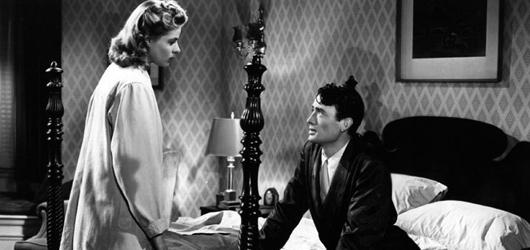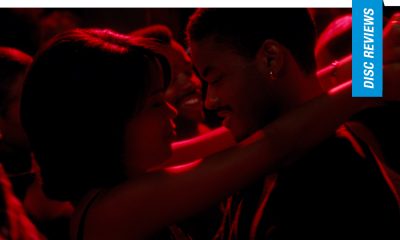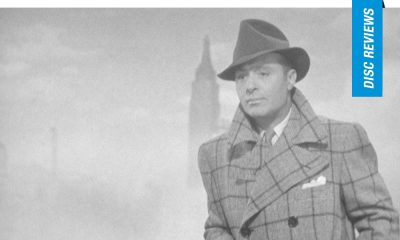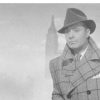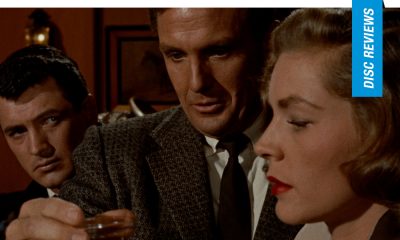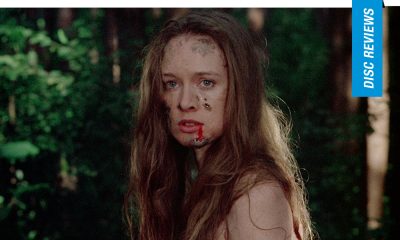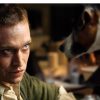Disc Reviews
Spellbound [Blu-ray] | DVD Review
“From the crisp formality of its acting, to the famous Salvador Dali designed dream sequence, Spellbound often seems to exist in a dimension other than our own. While the rational mind attempts to impose order on Hitchcock’s tantalizing clues and fragments, the narrative quietly expands to surprising proportions and pursues unexpected avenues, creating a sense of the hypnotically surreal.”
Alfred Hitchcock’s Spellbound is an aptly named motion picture. Recently released on blu-ray by Fox, this David O. Selznick produced thriller features twists and turns aplenty, and audiences will find themselves entranced by the time all is said and done. From the crisp formality of its acting, to the famous Salvador Dali designed dream sequence, Spellbound often seems to exist in a dimension other than our own. While the rational mind attempts to impose order on Hitchcock’s tantalizing clues and fragments, the narrative quietly expands to surprising proportions and pursues unexpected avenues, creating a sense of the hypnotically surreal.
But today’s viewers will not be mesmerized to the point of overlooking the story’s issues and inconsistencies, and there are a lot of them. Spellbound is at heart an amnesia melodrama, and we all know how dicey those can be, especially circa 1945, when screenwriters were besotted by the narrative possibilities of pop psychology. The film opens at an idyllic country hospital, where a beautiful young psychiatrist (Ingrid Bergman) spends her days attending to a variety of deeply troubled, but well groomed and fashionably dressed, schizophrenics.
The hospital is abuzz with anticipation; its new director (Gregory Peck), a respected leader in the field of mental disorders, is due to arrive for an inspection. But soon – the minute he walks through the door, in fact – it becomes clear the new honcho has a couple of loose screws himself, and Bergman’s casual description of a new swimming pool sends Peck into a near frenzy. Despite a strong physical attraction, Bergman begins to suspect her new boss is either an imposter or insane, possibly both, and eventually the pair embark on an adventure to solve the mystery. Along the way they’re branded as fugitives, pursued by the police, hide out in Rochester and go on a ski holiday complete with laughably unconvincing process shots.
It’s a testament to Hitchcock’s skill that he could hold the film together despite these overwrought and over-plotted impediments. Fortunately, he assembled a gifted supporting cast, well versed in classical technique, and they approach their roles with total conviction. John Emery, a prolific character actor who died relatively young and has been forgotten by history, shines as the wolfish Dr. Fleurot, a psychiatrist whose practice consists mainly of looking down Ingrid Bergman’s lab coat. Rhonda Fleming, as a patient with what passed in 1945 as nymphomania, is cleverly and effectively used early in the film to establish Bergman’s empathy and the hospital’s overall legitimacy. The quiet command of the great Leo G. Carroll enhances a pivotal role with dark and intriguing plasticity, while Michael Chekov, who received one of the film’s six Oscar nominations as Bergman’s eccentric mentor, provides heroism and comic relief in equal measure.
These superb performances make Spellbound an enjoyable film to watch, providing one can tolerate its frequent stretches of implausibility. Somehow, Bergman and Peck are able to avoid detection by New York’s Finest even though, among Grand Central Station’s squalid masses, they are the most beautiful couple to ever walk the Earth. The disastrous skiing sequence, in which the pair swoosh down an expert slope clad in elegant eveningwear, is intended as a dramatic, climactic epiphany, but it’s simply ridiculous. When an unseen character, introduced late in the film, takes on critical importance there’s a feeling of unfairness and rushed conclusion, as though even Hitch was getting a little fed up with the proceedings. But the gorgeous dream sequence, in which a Dali painting comes to life, is truly worth the price of admission, and ultimately prevents the film’s complete fall from grace.
Bergman and Peck try mightily, but the script gives them little to work with but platitudes and thankless situations. This is a standard trait of Hitchcock thrillers; his leads tend to be cluelessly uncynical, appalled that humanity or, in the case of The Birds, nature could be so cruel to them. Their shock causes them to be several beats behind the unfolding nefarious events, and the rest of the film is a game of catch up. Bergman appears much more comfortable in this scenario than Peck; his chiseled man-of-action persona counter intuitive to the role a confused victim. Much of the dramatic weight defaulted to Ingrid’s sublime shoulders and, fortunately for viewers, she put this fragile film on her back and carried it.
The transfer is true to the original aspect of 1:33:1, and looks quite good. As was the fashion at the time, prolific cameraman George Barnes used heavier diffusion on Miss Bergman’s close-ups than on the scene’s master shots. But thanks to careful attention by the colorists, there are no issues when the shots are intercut. Overall, the look is slightly flatter than expected, however it’s important to remember that Spellbound was not a noir conception, but generally a romance dressed in thriller accouterments. Except for a few isolated examples, 100% black is avoided save for the dream sequence. Sharpness is good if not rapier-esque, and grain is minimal.
The mono track is exceptionally free of noise and features excellent dynamic range. Miklós Rózsa’s Oscar winning score, while a little overbearing by today’s standards, punches through with lush clarity. Listen for the Theremin, an early electronic instrument capable of producing eerie, spine tingling wails. Rózsa was one of the first film composers to use the device, but it soon became a staple of horror and sci-fi movies.
Commentary with Author and Film Professor Thomas Schatz & Film Professor Charles Ramirez Berg
It’s safe to say that between these two learned gentlemen, there’s nothing about Spellbound that isn’t known. Their concurrent commentary provides a staggering wealth of information about Sleznick’s relationship with Hitchcock, the use of dreams to provide backstory, and the psychological significance of Ingrid Bergman’s eyeglasses, just for starters. The men do a good job of defining each of Spellbound’s three acts, and place its narrative within a classical perspective. Virtually every cast member and principle creative is discussed in detail and, refreshingly, Schatz and Berg are not shy about critiquing the film’s weaknesses. Hitchcock fans and those interested in Hollywood during the Selznick era will find the discussion lively and worthwhile.
Dreaming with Scissors: Hitchcock, Surrealism and Salvador Dalí
This 20 minute documentary provides interesting insight into Dali’s career and his interest in moviemaking. Hitchcock was a big fan of Dali’s work from Andalusian Dog and convinced Selznick to commission Dali to design Spellbound’s dream sequence. Storyboards found among Dali’s estate reveal that the sequence was originally intended to be much longer, with intense and shocking imagery. This supplement is recommended viewing.
Guilt by Association: Psychoanalyzing Spellbound
A number of film historians and clinical psychologists weigh in on depictions of therapy in Spellbound, and declare it the first film to deal with psychoanalysis in a meaningful way. Sleznick’s personal experience with analysis is discussed, along with experimental applications of Freudian techniques on WWII soldiers returning home with PTSD. There’s little here relating to Spellbound as cinema, but the 20 minute segment provides an interesting look at the treatment of emotional disorders before the advent of drug-based therapies.
A Cinderella Story: Rhonda Fleming
The noted actress and philanthropist offers her memories of life on the set of Spellbound, revealing Selznick as something of a frustrated director. Discovered by a talent scout while still in high school, Fleming recounts how she had never even been on a date when she was cast as Spellbound’s resident manipulative sex addict. Miss Fleming discusses highlights from her film career as well as the cancer institute she founded in the 1990s. At 10 minutes, the supplement is must viewing for fans of the famous redhead.
1948 Radio Play
A condensed version of Spellbound was featured on Lux Radio Theater in 1948, and is presented here in its entirety. Joseph Cotton and the Italian actress Valli star in the radio play, here pared down to 60 minutes.
Hitchcock Audio Interview
In this audio only segment, Peter Bogdanovitch and Hitchcock examine Spellbound’s recurrent guilt motif and the use of symbolism. Hitchcock addresses the critics who derided the film as simplistic, and describes the great care taken to portray the science of psychoanalysis accurately. It’s interesting to hear the director’s first hand thoughts on the film, and Bogdanovitch does a good job keeping the 15 minute segment on track.
Original Theatrical Trailer
The trailer, in true Sleznickian style, emphasizes the names and personalities involved in Spellbound rather than the particulars of the plot.
Despite its narrative convolutions and conveniences, Spellbound remains a worthwhile entertainment due to strong performances and some imaginative imagery. Fans of the golden age of Hollywood will find the film a textbook example of the aesthetics of a bygone era, while those interested in the art of visual storytelling will marvel at Alfred Hitchcock’s controlled and deliberate execution. Casual viewers will likely find the film intolerably hokey and frankly, that’s wholly understandable. Spellbound ultimately receives a guarded recommendation, geared toward enthusiasts of Peck, Bergman and Hitchcock. If you liked the film in standard def, you’ll love the blu-ray.
Reviewed by David Anderson
Movie rating – 3
Disc Rating – 3.5



